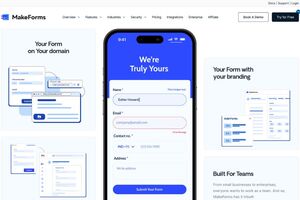7 Key Trends in Online Form Builder Software You Need to Know
الجسم
In the digital age, online form-builder software has become an indispensable tool for businesses and organizations. From collecting customer data to processing orders, these platforms streamline various processes and enhance user experience. As the demand for efficient and user-friendly form builders continues to grow, the market is evolving rapidly. Here are seven trends shaping the future of the online form builder software market.
- Integration with Advanced Analytics
Modern businesses rely heavily on data-driven insights to make informed decisions. Online form builder software is no exception. The integration of advanced analytics tools within form builder platforms is becoming increasingly prevalent. These analytics features provide users with valuable data on form completion rates, user engagement, and drop-off points.
By leveraging these insights, businesses can optimize their forms to improve user experience and increase conversion rates. Furthermore, advanced analytics enable organizations to gain a deeper understanding of their audience, allowing for more personalized and targeted marketing strategies.
- AI-Powered Form Automation
Artificial Intelligence (AI) is revolutionizing the way online form builder software operates. AI-powered form automation capabilities can significantly reduce manual data entry and streamline form completion processes.
For instance, AI can auto-fill certain fields based on user data, predict user responses, and even identify potential errors or inconsistencies in real-time. This not only enhances the efficiency of form completion but also improves the accuracy and reliability of the data collected.
- Mobile-Optimized Design
With the increasing use of mobile devices, it's essential for online form builder software to offer mobile-optimized designs. A responsive design ensures that forms are accessible and easy to use on various screen sizes and devices.
Mobile-optimized form builders provide a seamless user experience, allowing respondents to complete forms on the go without any hindrance. This trend is particularly crucial for businesses targeting mobile users or those in industries where field data collection is prevalent.
- Enhanced Security Features
In an era where data privacy and security are paramount, online form builder software is incorporating enhanced security features to protect sensitive information.
Advanced encryption methods, multi-factor authentication, and compliance with data protection regulations such as GDPR and CCPA are becoming standard features in modern form builder platforms. These security measures instill trust among users and help businesses comply with legal requirements, reducing the risk of data breaches and unauthorized access.
- Customization and Branding Options
Personalization is key to creating a memorable user experience. As a result, online form builder software is offering more customization and branding options to help businesses align their forms with their brand identity.
From customizable templates and themes to the ability to add logos, colors, and fonts, these features enable organizations to create visually appealing and consistent forms that resonate with their audience. Customization also enhances brand recognition and reinforces brand loyalty among customers.
- Integration with CRM and Marketing Platforms
Seamless integration with Customer Relationship Management (CRM) and marketing platforms is becoming a standard requirement for online form builder software.
Integration with CRM systems allows businesses to automatically sync form data with their customer database, enabling them to track interactions, segment leads, and nurture customer relationships more effectively. Similarly, integration with marketing platforms facilitates automated email marketing campaigns, lead scoring, and personalized content delivery based on form responses.
- Collaborative and Workflow Features
Collaboration and workflow management are crucial for organizations with multiple team members involved in form creation and data processing. Online form builder software incorporates collaborative features such as real-time editing, comments, and task assignments to streamline teamwork and improve productivity.
Additionally, workflow automation capabilities enable businesses to automate repetitive tasks, route form submissions to the appropriate departments or team members, and set up approval processes, ensuring a smooth and efficient data collection and processing workflow.
- Accessibility Compliance
Ensuring that online forms are accessible to all individuals, including those with disabilities, is increasingly important. Accessibility compliance features in form builder software ensure that forms are compatible with assistive technologies such as screen readers and keyboard navigation.
These features include options for adding alternative text to form elements, providing keyboard shortcuts for navigation, and ensuring proper semantic markup for screen readers. By prioritizing accessibility, businesses can reach a wider audience and demonstrate their commitment to inclusivity.
- Interactive Form Elements
To engage users and enhance the user experience, online form builder software is incorporating more interactive elements. These may include conditional logic, which dynamically adjusts form fields based on user responses, or interactive progress indicators to guide users through multi-step forms.
Interactive elements not only make forms more engaging but also help streamline the completion process by presenting users with relevant questions and reducing clutter. By making forms more interactive, businesses can increase completion rates and gather more accurate data.
- Voice-Enabled Form Submission
With the rise of voice-enabled devices and virtual assistants, voice-enabled form submission is emerging as a new trend in online form builder software. Users can now complete forms by speaking their responses aloud, rather than typing them out.
Voice-enabled form submission not only caters to users who prefer voice input but also enables hands-free interaction, making it convenient for users on the go or those with limited mobility. Integrating voice recognition technology into form builder platforms opens up new possibilities for interaction and accessibility.
Conclusion
From integration with advanced analytics and AI-powered automation to mobile-optimized design, enhanced security features, and seamless integration with CRM and marketing platforms, the future of online form builder software is promising.
By embracing these trends and adopting innovative features and functionalities, businesses can leverage online form builder software to streamline processes, improve the user experience, and gain valuable insights to drive growth and success in the digital era.









تعليقات